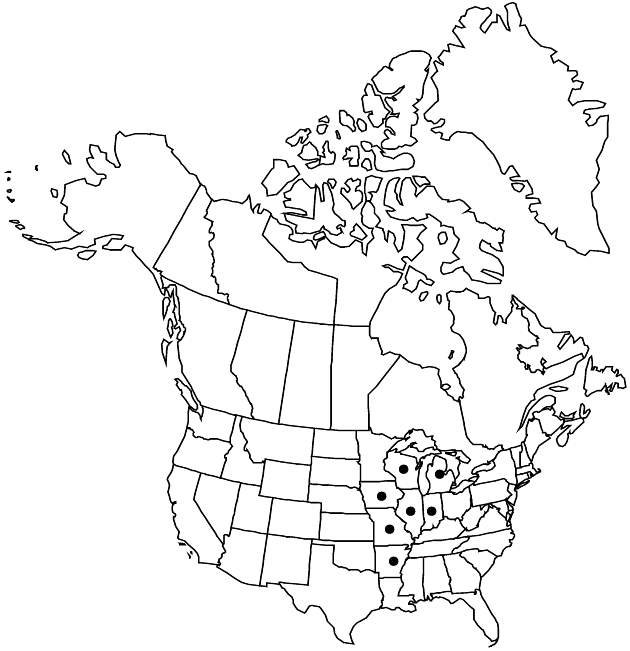Eurybia furcata
Phytologia 77: 259. 1995.
Plants (30–)50–120 cm; strongly in clones or scattered clumps, eglandular; rhizomes elongate, fleshy. Stems 1–5+, erect, simple, ± flexuous distally (± ridged from decurrent leaf bases), glabrate proximally, sparsely villous distally. Leaves basal and cauline (grayish green abaxially), bases often oblique, margins serrate, veins prominent, abaxial faces scabrous, adaxial hirsute; basal and proximal cauline withering by flowering (rosettes produced in late season, absent in spring), short-petiolate, petioles winged, sheathing, blades ovate-lanceolate, 40–130 × 20–90 mm, bases rounded to subcordate, apices obtuse to acute; mid short-petiolate, narrowly winged, wings revolute, bases dilated, sheathing, ciliate, blades ovate to lance-ovate, 100–120(–150) × (30–)60–80 mm, gradually reduced distally, bases shallowly cordate or truncate to rounded, margins sharply serrate, teeth mucronate, apices acuminate; distal (arrays) subpetiolate or sessile, ovate, 8–70 × 4–23 mm, bases sheathing or clasping. Heads 4–32+ in flat-topped, corymbiform arrays. Peduncles 0.5–3(–5) cm, villous; bracts 0–3. Involucres campanulate, 6–8(–10) mm, much shorter than pappi. Phyllaries ca. 40 in 5 series, oblong (outer) to linear-lanceolate (inner), strongly unequal, membranous, bases indurate and low-keeled or rounded abaxially, green zones in distal 1/4–1/3, obovate, poorly defined, margins hyaline, scarious, villoso-ciliate, inner often purplish, apices appressed, obtuse to rounded, faces villous, eglandular. Ray florets (12–)15–20; corollas white, sometimes becoming pink or lavender, 12–18 × 1–2.5 mm. Disc florets 25–35+; corollas cream or light yellow becoming purple, 6–7(–8) mm, slightly ampliate, tubes cylindric, lengths about twice funnelform throats, lobes erect, lanceolate, 0.8–1.2 mm (glabrous). Cypselae brown, fusiform, (2.5–)3–3.5(–4) mm, ribs 8–10(–12), crowded, stramineous to tan, faces ± strigillose; pappi of tawny (apically sometimes clavellate) bristles 6–7 mm, equaling or slightly shorter than disc corollas. 2n = 18.
Phenology: Flowering late Jul–Oct.
Habitat: Calciphile, ± open habitats (± shade intolerant), limestone, sandstone and dolomite areas, mostly n-facing slopes, seepy bluffs, moist deciduous woods, especially along streams, sometimes disturbed sites
Elevation: 200–600 m
Distribution

Ark., Ill., Ind., Iowa, Mich., Mo., Wis.
Discussion
D. H. Les et al. (1991b) studied the population genetics of this restricted taxon, and Les et al. (1992) its distribution and autecology in Wisconsin. J. A. Reinartz and D. H. Les (1994) showed that the species is developing self-compatibility in response to small populations.
Eurybia furcata is uncommon throughout its range and is considered endangered or threatened in all states where it occurs; it is known only from historic records in Arkansas. It is in the Center for Plant Conservation’s National Collection of Endangered Plants.
Selected References
None.